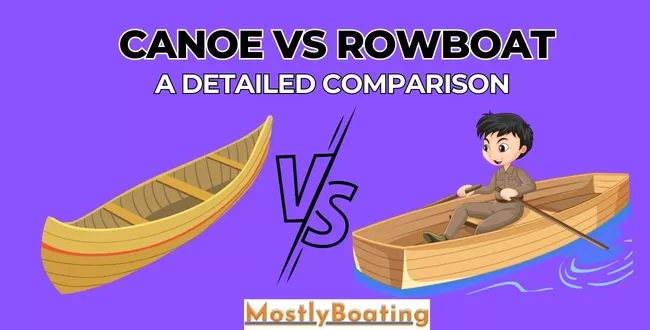Let’s suppose you’re in the market to purchase a new vehicle for navigating the tranquil waterways. While there are numerous options, the two rowboats and canoes really stick out from the pack.
So who is the ‘go-to winner’ between canoe vs rowboat?
Simply put, a canoe is an open-top vessel that’s well-suited for calm waters, including whitewater. On the other hand, rowboats are enclosed vessels that can handle rougher conditions to some extent. They are propelled by oars attached to pivoting oarlocks and are relatively faster, while canoes utilize a single-bladed paddle to move forward and are just the opposite in terms of speed.
With that said, let’s explore canoe vs rowboat briefly along with some valuable information you would love to know.
Key Takeaways on Canoe Vs Rowboat
What are the main differences between rowboats vs canoe?
Design: A canoe is an open-top narrow vessel with a pointed structure, while rowboats are typically enclosed watercraft that are wider in shape.
Seats: Canoes have bench-like seats, meaning you can shift from one position to another. Meanwhile, rowboats consist of seats that move forward and backward.
Propulsion: You must utilize a single-bladed paddle to operate a canoe. On the flip side, rowboats simply require oars for propulsion.
Stability: Being wider and flat-bottomed, rowboats provide excellent stability. And canoes are just less stable due to narrow design.
Which one is best for me?
The best option for you depends upon a number of factors. The major ones include intended use and propulsion mechanism that suits you better.
What is a Canoe?
A canoe, as mentioned, is a watercraft that’s used to explore the outdoors and enjoy the simplicity of nature. Typically, the vessel is pointed at both ends and requires the usage of canoe paddles for propulsion.
In addition, watercraft has been utilized by various cultures throughout history for transportation, recreation, and even sport.
With regard to construction, the little vessel is often crafted from materials like wood, fiberglass, or aluminum. Being narrow in design, it is well-suited for various water bodies, from calm lakes to flowing rivers.
What is a Rowboat?
The rowboat is one of the most basic forms of human-powered aquatic travel. Typically, it possesses a flat underside, a pointed front end called the bow, and a level rear part known as the transom. This design supports the attachment of oar locks and oars.
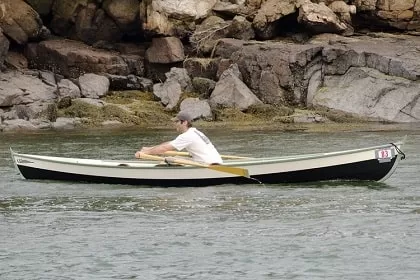
Moving forward, the vessel serves various purposes, be it leisurely rowing or transportation of cargo. In terms of construction, it’s mainly crafted with wood, fiberglass, aluminum, and inflatable substances.
Main Differences between Row Boat vs Canoe
Choosing the right vessel for your water water tour is paramount, as it ensures the safety and comfort of passengers. So, which is better rowboat vs canoe?
To give you an idea, we’ve highlighted some key distinctions between these two watercraft.
Method of Propulsion:
- Rowboats: Oars, as mentioned, are required to propel a rowboat. Rowers face the direction of travel, using a back-and-forth motion to move the boat ahead.
- Canoes: Paddles take charge of propelling canoes. Canoeists either kneel or sit on benches inside the canoe to record a movement.
Design and Shape:
- Rowboats: It usually boasts a broader and more stable hull design. Though their size and shape can vary, one thing is common in most models: a more squared-off back end.
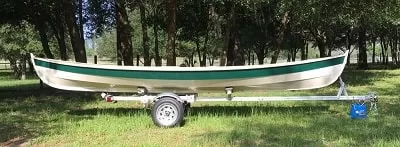
- Canoes: The watercraft feature a sleeker, narrower profile. Its open-top structure allows for easy entry and exit, making them suitable for tranquil water passages such as rivers and lakes.
Seating and Capacity:
- Rowboats: Seating in rowboats can cater to multiple rowers based on size. Some even come with a coxswain, who steers and coordinates rowers in competitive rowing. Alternatively, they can be operated by a single individual.
- Canoes: They usually hold a smaller number of people, typically ranging from 1 to 3 occupants, although larger canoes can accommodate more. Canoes offer flexible seating options, allowing occupants to kneel or sit on benches.
Weight Limit:
- Rowboats:
Rowboats generally have a higher weight capacity compared to canoes. Their broader design and often sturdier construction can accommodate more weight, making them suitable for carrying multiple passengers or heavier loads.
- Canoes:
Canoes typically have a lower weight capacity than rowboats due to their narrower hull and design. While they can still carry passengers and gear, canoes might have limitations on the total weight they can safely accommodate.
Similarities Between Canoe vs Rowboat
Beyond the above differences, there are a handful of similarities too between canoes and rowboats you must know before making a purchase.
Let’s get started with them:
- Both canoes and rowboats are small watercrafts designed for human-powered propulsion.
- They share the basic equipment for propulsion and that’s oars. However, there’s a subtle difference between the oars used by both vessels.
- Both boats require occupants to exert manual effort for propulsion, whether it’s through paddling or rowing.
- Canoes and rowboats provide environmentally friendly alternatives to motorized vessels, as they rely solely on human power.
- Being powered by oars, both watercraft silently glide through the water, making them ideal for observing wildlife without disturbance.
Advantages and Limitations of both Rowboats and Canoes
As far, you know the major differences and similarities between rowboats and canoes. Now it’s time to discuss the advantages and limitations of both vessels.
For your ease, we have curated a few tables to address the advantages and limitations of rowboats and canoes.
Rowboats:
| Advantages | Limitations |
| Stable and balanced | Require more effort |
| Easy to maneuver | Limited seating capacity |
| Suitable for fishing | Slower than canoes |
| Good for multiple riders | Heavier to transport |
| Great for rowing exercise | Less agile in tight spots |
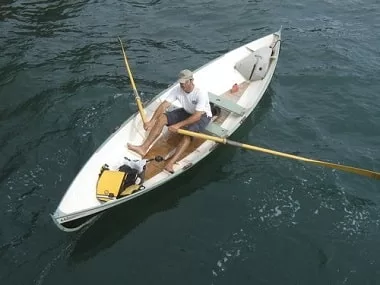
Canoes:
| Advantages | Limitations |
| Light and easy to carry | Less stable than rowboats |
| Can navigate in shallow waters | Can be tricky to paddle |
| Faster than rowboats | Limited protection from elements |
| Higher seating capacity | Can tip over easily if not balanced |
| Versatile for various water types | Requires more coordination |
Propulsion Method (Paddling in Canoe Vs Rowing in Rowboat)
The propulsion mechanism of your chosen watercraft plays a significant role in your overall experience. Canoes rely on paddling, offering a rhythmic and engaging way to navigate the waters.
This method provides a full-body workout and allows you to control your canoeing speed and direction with ease.
Rowboats, on the other hand, use oars for rowing. This technique can offer a more efficient means of propulsion, particularly for longer distances.
Seating Arrangement and Capacity (Canoe Vs Rowboat)
When it comes to choosing between canoes and rowboats, one of the crucial aspects to consider is the seating arrangement and capacity.
Canoes usually provide an open design with benches that allow multiple canoe passengers to sit comfortably. This makes them a great option for family outings or group adventures.
On the other hand, rowboats often feature a more compact design with fixed seating positions. This can be advantageous for solo expeditions or intimate fishing trips.
Weight & Portability
The weight and portability of your chosen watercraft can significantly impact your overall experience. Canoes, typically constructed from lightweight materials such as aluminum or fiberglass, are easier to transport the canoe and handle. They can be carried by a single person or loaded onto roof racks without much hassle.
Rowboats, with their sturdier construction, might require more effort to transport, especially if you’re venturing alone. However, their durability can make them an excellent choice for longer journeys.
Weight Limit and Capacity
Determining the weight limit and capacity of your chosen vessel is vital to ensure safety and comfort.
Canoes generally have a higher weight limit, accommodating more passengers and canoeing accessories/gear. This makes them suitable for extended trips like canoe camping where you need to carry camping equipment or other essentials.
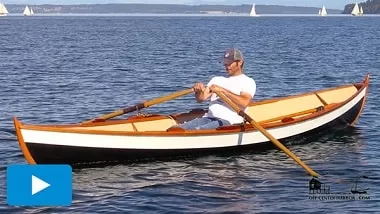
Rowboats, while having a lower weight limit, are still well-suited for leisurely fishing trips or short excursions with a limited number of people.
Material and Construction
The material and construction of your watercraft play a crucial role in its performance and durability. Canoes are often constructed from lightweight canoe materials that enhance their maneuverability and speed on the water.
Rowboats, designed with sturdier materials like wood or heavy-duty plastic, offer better resistance to impacts and wear.
Depending on your intended use, you can choose a watercraft that aligns with your preferences for strength and longevity.
Suitability for Different Water Conditions
Understanding the water conditions you’ll be navigating is essential for selecting the right watercraft. Canoes are versatile and can handle various water types, from calm lakes to gentle rivers. They offer stability and maneuverability, making them a well-rounded choice.
Rowboats, with their more solid build, are better suited for calmer waters, such as lakes and ponds. Their design may make them less suitable for faster-moving rivers or choppier waters.
Which one offers better stability for fishing: canoe or rowboat?
When it comes to stability for fishing, both canoes and rowboats have their merits. Canoes provide a stable platform for anglers, especially when equipped with outriggers or stabilizers. This stability can be enhanced by choosing wider models.
Rowboats, with their lower center of gravity and sturdy build, can offer excellent stability for fishing, allowing you to cast your line with confidence.
Cost and Recreational Use
The financial aspect is often a key factor in the decision-making process. Canoes and rowboats span a range of price points, with factors such as materials, construction, and features influencing the cost.
Canoes often come at a slightly higher cost due to their versatility and larger capacity. Rowboats, while generally more affordable, still offer a reliable option for recreational use.
In the end, you must consider your budget and intended use when making your decision.
Choosing the Right Vessel for Your Needs
Boating is done in a number of circumstances. Thus your choice of a suitable vessel can vary according to it. Here’s a breakdown to help you understand that better:
Situation # 1: Discovering a Serene Lake for a Peaceful Voyage
When aiming to just sail on the calm waters without any additional activities like fishing, a canoe might be the ideal choice. It’s because this type of vessel has an open design, which facilitates relaxed seating.
Also, the best part is that you will have enough space to store your snacks, juices, and even photography gear to set the picnic mood just right. Moreover, since canoes have a wide hull and a flat bottom, you would not have to put in much effort to maintain their stability.
Situation # 2: Fishing in a Quiet River Bend
For fishing purposes, a rowboat can be the perfect pick for a number of reasons. Firstly, this watercraft has a wide space for accommodating your fishing equipment, along with coolers and tackle boxes.
Additionally, rowboats offer a much more stable platform, streamlining the casting and reeling process. So you can get your hands on as many delicious fish as possible!
Lastly, rowing while fishing offers a unique merit allowing you to take the precise position aiming towards the best fishing spot. And that too without adjusting the boat’s direction itself.
Situation # 3: Navigating a Narrow Mashland
Next up, going through narrow water bodies calls for the need for canoes because of their maximum agility. Thanks to its lightweight construction, maneuvering through tight areas surrounding multiple obstacles is now a breeze.
Moreover, canoes have the power to glide through shallow waters pretty easily, which many larger boats might not be able to conquer.
Situation # 4: A Relaxed Adventure in a Pond
In this situation, both types of boats deliver equally efficient results. First up, they facilitate personal space so there’s no one around to disrupt your solo journey. In addition to this, both rowing and paddling the canoe offer you maximum control over pacing so you can go at your own rhythm, forgetting all worldly worries.
Situation # 5: Speedy Exercise on an Open Bay
Rowboats are ideal for this situation, considering their utmost efficiency and a longer and narrower hull that promotes stability. With this construction style, it is possible to cut through the waters with lesser resistance, eventually helping to achieve higher speeds.
Moreover, when you row a boat, you are indulged in a full-body workout of various muscle groups at work – a perfect idea to have an intense workout session in open waters.
Factors on which you should choose the vessel
Here are some essential factors you need to consider when confused about choosing a canoe or rowboat:
- Purpose of use
- Number of people
- Skill level
- Water conditions
- Speed
- Maneuverability
- Budget
- Weight
- Durability
Rowing vs Paddling Techniques – Comparison
Both paddling and rowing techniques are different in multiple areas, as discussed below:
Equipment Connection:
Paddles are handheld, and you can not fix them by any means. This also makes them easy to steer freely. In comparison, oars attached to rowboats have locks on them, thus requiring rowers to pull them off when moving the boat.
Facing Forward:
When paddling, you need to face the direction in which you are traveling. However, rowing is a bit the opposite as you first need to move backward.
Steering Blade:
Paddling activity needs a single blade to keep the vessel straight, which promotes flexibility for maneuvering. Meanwhile, rowing it’s two blades that are steered to maintain the proper direction of the watercraft.
Types of Canoes and Rowboats
| Canoe Types | Description |
| Open canoe | Traditional and versatile |
| Whitewater canoe | Maneuverable in rapids |
| Touring canoe | Long-distance, stable |
| Inflatable canoe | Portable, easy storage |
| Racing canoe | Sleek, fast, and competitive |
| Rowboat Types | Description |
| Flash water shell | Narrow and swift |
| Open water shell | Sleek design |
| Skiff | Shallow and versatile use |
| Touring rowboat | Long-distance and offers stability |
| Work rowboat | Sturdy, used for utility tasks |
Can I use a canoe for rowing, or a rowboat for paddling, interchangeably?
Yes, it’s possible to use both watercraft interchangeably, but we don’t recommend doing so. Both canoes and rowboats are designed for specific purposes and, thus, should be used as intended. Moreover, doing so will also rob you of the efficiency and comfort both vessels come with.
Is it possible to convert a rowboat into a canoe or vice versa with modifications?
Since canoes lack much stability, you’d be required to modify them for a seamless conversion of this vessel into a canoe or even vice versa.
Here are two major methods that can help:
Method # 1
- Using a suitable tool, cut your canoe in half. Make sure this step is attempted lengthwise.
- Now you need to insert a spacer in the middle, which will increase the canoe’s width by 3 times.
- Finally, connect both the pieces together, making sure they are connected strongly.
- Insert oarlocks on both sides of the canoe, and then add oars as well to finish off the process.
Method # 2
There’s no step-wise procedure for this, as you just need to add canoe outriggers, oarlocks, and oars.
Since the conversion process needs a number of equipment, you might miss out on buying one or more. Therefore, it’s always better to purchase a kit that’s specifically designed for this purpose. It usually comprises an aluminum frame bolting into the canoe, a sliding seat, and outriggers as well for the oar locks.
Simply put, you need to reinforce the canoe’s gunwales so oar locks can be installed for converting it into a row boat.
Wrapping Up
To sum it up, when you’re picking between canoe vs rowboat, remember that it all depends on what you’re looking for. Canoes are like the open road of watercraft, offering space for a crew and a comfortable perch to enjoy the sights.
On the other hand, rowboats are like reliable companions, perfect for fishing or a peaceful row. Each boat has its strengths, so consider where you’ll be cruising and what kind of experiences you want.
Whether you’re gliding through calm lakes or gently rolling down a river, both canoes and rowboats are ready to make your time on the water memorable.
FAQs – Comparison b/w rowboat vs canoe
Are Both canoes and rowboats of their boats?
Yes, both canoes and rowboats are types of boats. Canoes are narrow and open, while row boats are broader and enclosed.
Are canoes older than rowboats?
Canoes are generally considered older, with their origins dating back thousands of years to indigenous cultures. Rowboats, though ancient as well, have a less precise timeline.
Which one is safe and easy to use for beginners?
Canoes tend to be more stable and forgiving for beginners due to their design. On the other hand, rowboats can be trickier to maneuver, especially for those new to rowing.
Which boat is more suitable for long-distance expeditions on rivers or open waters?
Rowboats are often preferred for long-distance expeditions due to their storage capacity and ability to navigate different types of water. They’re better equipped for extended journeys.
Can I install the trolling motor with both a rowboat and canoe?
Yes, both rowboats and canoes can be equipped with trolling motors, offering propulsion assistance and making them suitable for various water activities.
Can I use the same type of trolling motor for both watercraft?
In most cases, the same type of canoe trolling motor can be used for both rowboats and canoes. However, it is possible as long as the motor’s specifications match the weight and design of the watercraft.
Which one of them is difficult to maintain?
Rowboats might require more maintenance due to their mechanical components like oars and rowlocks. Canoes generally have fewer moving parts and can be easier to maintain.
Which one of them requires a license or permit for usage?
The requirement for a license or permit varies by location and waterway regulations. Both canoes and rowboats may require permits for certain areas, especially if they are motorized. Be sure to check local laws before having a ride.

Jack Bennett, a passionate pedal boating enthusiast, and marine engineer by day, is here to share my knowledge and love for this exciting sport with you all. Happy Boating!
